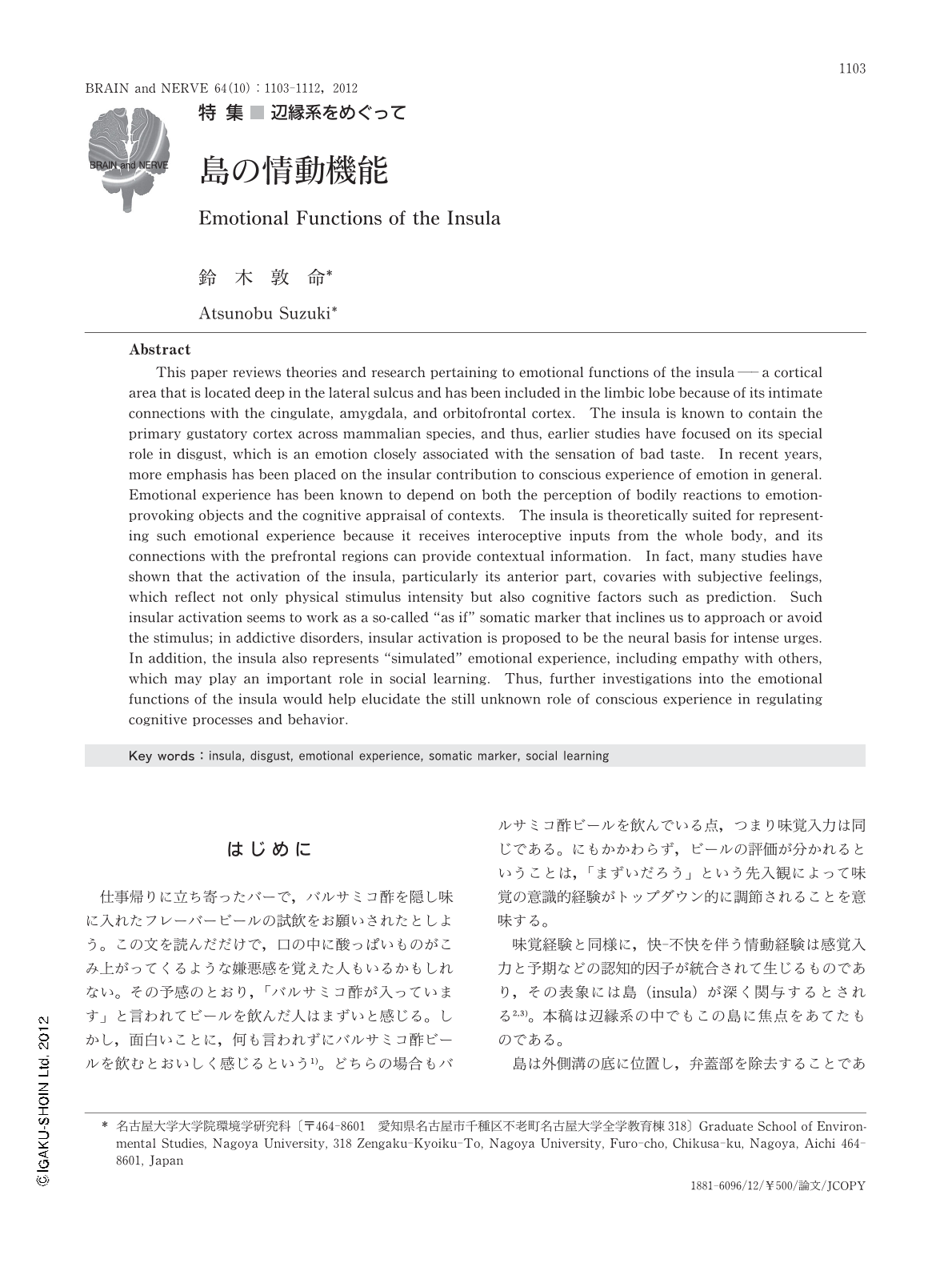Japanese
English
- 有料閲覧
- Abstract 文献概要
- 1ページ目 Look Inside
- 参考文献 Reference
はじめに
仕事帰りに立ち寄ったバーで,バルサミコ酢を隠し味に入れたフレーバービールの試飲をお願いされたとしよう。この文を読んだだけで,口の中に酸っぱいものがこみ上がってくるような嫌悪感を覚えた人もいるかもしれない。その予感のとおり,「バルサミコ酢が入っています」と言われてビールを飲んだ人はまずいと感じる。しかし,面白いことに,何も言われずにバルサミコ酢ビールを飲むとおいしく感じるという1)。どちらの場合もバルサミコ酢ビールを飲んでいる点,つまり味覚入力は同じである。にもかかわらず,ビールの評価が分かれるということは,「まずいだろう」という先入観によって味覚の意識的経験がトップダウン的に調節されることを意味する。
味覚経験と同様に,快-不快を伴う情動経験は感覚入力と予期などの認知的因子が統合されて生じるものであり,その表象には島(insula)が深く関与するとされる2,3)。本稿は辺縁系の中でもこの島に焦点をあてたものである。
島は外側溝の底に位置し,弁蓋部を除去することであらわになる(Fig.1)。島は,帯状回や扁桃体と神経連絡を持ち,その前腹側端は眼窩前頭皮質と連続しているなどの解剖学的特徴を有するため,辺縁系回路の中に含められてきた4)。実際,島は辺縁系の主要な機能である情動と関連した活動がヒト神経イメージング研究で最も頑健に観測される脳領域の1つである5)。
「辺縁系」と「情動」という概念の持つ曖昧性・複合性を批判したJoseph LeDouxは,特定の神経構造が特定の情動において果たす役割に着目するという研究方略を提案した6)。この立場のもと,彼は恐怖条件づけを支える扁桃体回路の詳細を解明し,今日における情動の神経科学研究の隆盛に大きく貢献した7)。同様に,島は嫌悪という特定の情動に関わりの深い脳領域として注目されてきた8)。しかし,先述のように,現在では,島は情動の種類によらず,その意識的・主観的経験に重要な役割を果たすのではないかと提案されている2,3)。本稿では,これら島の情動機能をめぐる種々の話題を概観する。
Abstract
This paper reviews theories and research pertaining to emotional functions of the insula――a cortical area that is located deep in the lateral sulcus and has been included in the limbic lobe because of its intimate connections with the cingulate, amygdala, and orbitofrontal cortex. The insula is known to contain the primary gustatory cortex across mammalian species, and thus, earlier studies have focused on its special role in disgust, which is an emotion closely associated with the sensation of bad taste. In recent years, more emphasis has been placed on the insular contribution to conscious experience of emotion in general. Emotional experience has been known to depend on both the perception of bodily reactions to emotion-provoking objects and the cognitive appraisal of contexts. The insula is theoretically suited for representing such emotional experience because it receives interoceptive inputs from the whole body, and its connections with the prefrontal regions can provide contextual information. In fact, many studies have shown that the activation of the insula, particularly its anterior part, covaries with subjective feelings, which reflect not only physical stimulus intensity but also cognitive factors such as prediction. Such insular activation seems to work as a so-called "as if" somatic marker that inclines us to approach or avoid the stimulus; in addictive disorders, insular activation is proposed to be the neural basis for intense urges. In addition, the insula also represents "simulated" emotional experience, including empathy with others, which may play an important role in social learning. Thus, further investigations into the emotional functions of the insula would help elucidate the still unknown role of conscious experience in regulating cognitive processes and behavior.

Copyright © 2012, Igaku-Shoin Ltd. All rights reserved.


